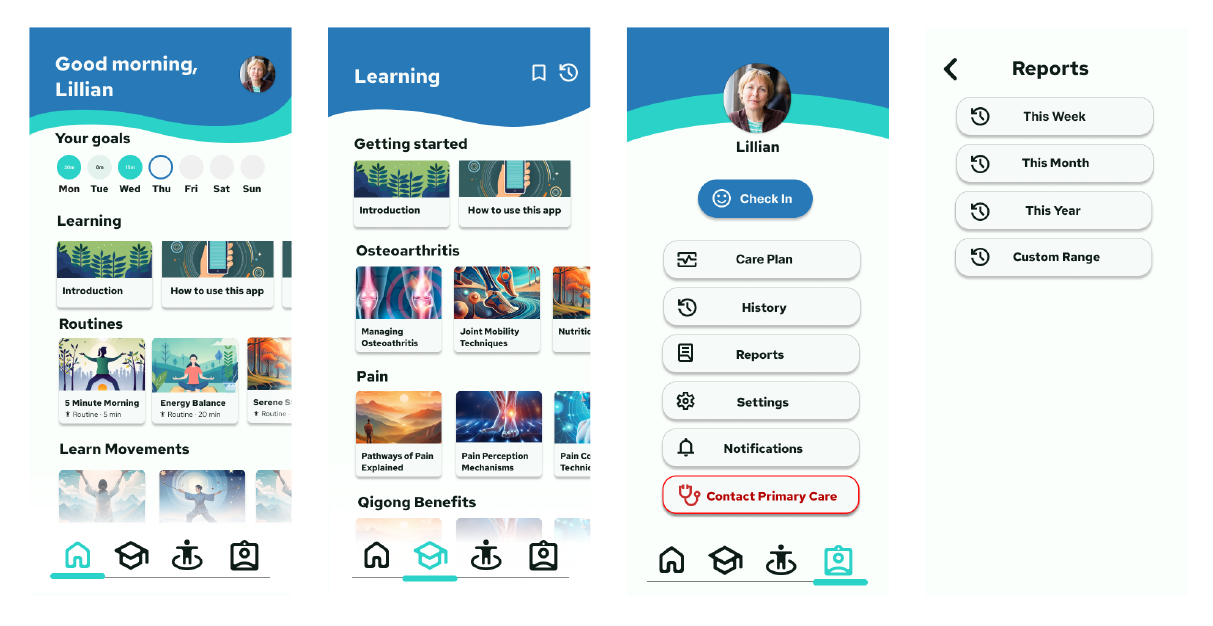
QiFlow App
Project Overview
The QiFlow App project was developed as part of a collaborative effort aimed at providing a digital solution for individuals suffering from chronic pain. Our group, Otter’s Group, focused on designing a comprehensive e-health app that offers multimodal approaches to pain management, empowering users to improve their quality of life through consistent self-care routines. My key contributions centered around the development of the app's user interface and research on the target audience.
Problem
Chronic pain is a growing issue, affecting 3.4 million Australians as of 2024. Chronic conditions such as fibromyalgia, lower back pain, and osteoarthritis severely impact the quality of life for many and have high social and economic costs. The need for accessible pain management solutions has grown due to limited access to specialised clinics, with only 2% of people with chronic pain utilising such services. The QiFlow app aims to bridge this gap by offering accessible, home-based self-management techniques and educational resources for chronic pain sufferers.
Target Audience Analysis
The primary audience for QiFlow includes individuals aged 55 to 65+ years who are focused on improving self-management of pain. These individuals are self-motivated and prepared to take an active role in managing their pain conditions.
Solution: QiFlow App Design
The QiFlow app offers a holistic approach to pain management through the following features:
- Educational Resources: Videos and blog posts that provide information on pain management techniques, therapeutic exercises, and lifestyle tips.
- Motivational Elements: Encouraging self-assessment and progress tracking through a built-in pain scale.
- Distraction Techniques: Content focused on helping users shift attention away from pain through guided meditations, relaxing visualisations, and creative activities.
- TV Casting Capabilities: The app allows users to cast instructional videos and exercises to a TV screen for a more engaging experience in Qi Gong. This incorporates AR technology, to give feedback to users on their Qi Gong practice.

UI Design and Development
- Designed the user interface for the QiFlow app using Figma, focusing on user-facing elements.
- Created a consistent visual language that reflects the calming and therapeutic objectives of the app.
- Used soothing colour palettes and accessible typography to meet the needs of our target demographic.

Key Takeaways
This project was helpful in learning the importance of understanding specific needs of a target audience when designing digital health solutions. Through thorough research and empathy-building activities, we identified key motivations and barriers faced by chronic pain sufferers. Developing a user-friendly interface for this demographic required careful consideration of accessibility principles, visual hierarchy, and interaction design.
Conclusion
The QiFlow app is a digital tool that addresses the growing need for accessible pain management solutions. By incorporating user-centric design principles and leveraging AR technology, QiFlow empowers users to take an active role in managing their chronic pain conditions. This project provided me with valuable experience in UX design, research, and product development, as well a great opportunity for collaboration with my peers to design an app that could improve health outcomes for vast numbers of people.


